Impact of Feminism on Studies of Women, Gender, and Crime
VerifiedAdded on 2022/12/29
|7
|1969
|65
AI Summary
This essay explores the impact of feminism on the study of women, gender, and crime. It discusses the intersection of victimization and offending, treatment within the criminal equality framework, and the experiences of women who offend. The essay also highlights how feminism has shaped the understanding of women's experiences in the criminal justice system.
Contribute Materials
Your contribution can guide someone’s learning journey. Share your
documents today.
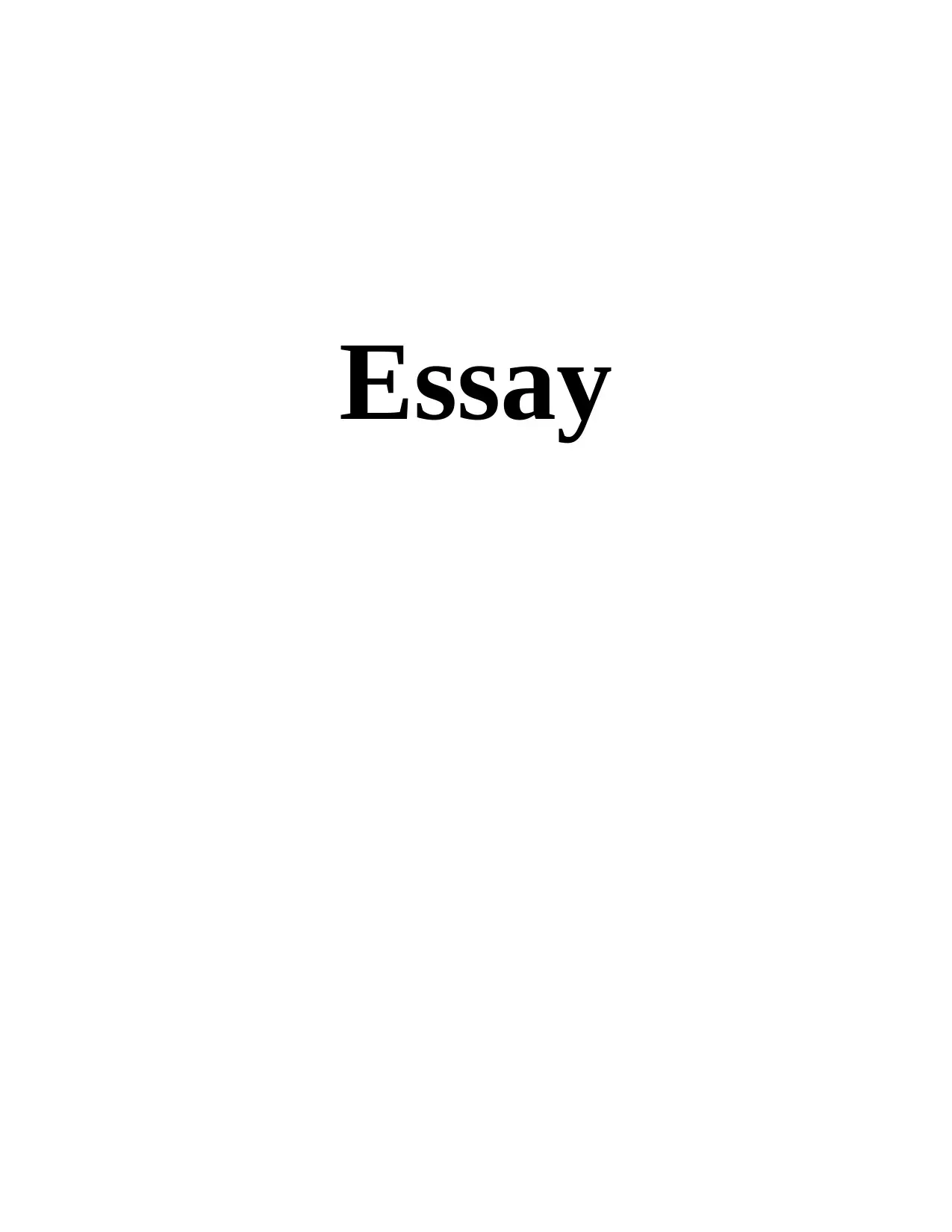
Essay
Secure Best Marks with AI Grader
Need help grading? Try our AI Grader for instant feedback on your assignments.
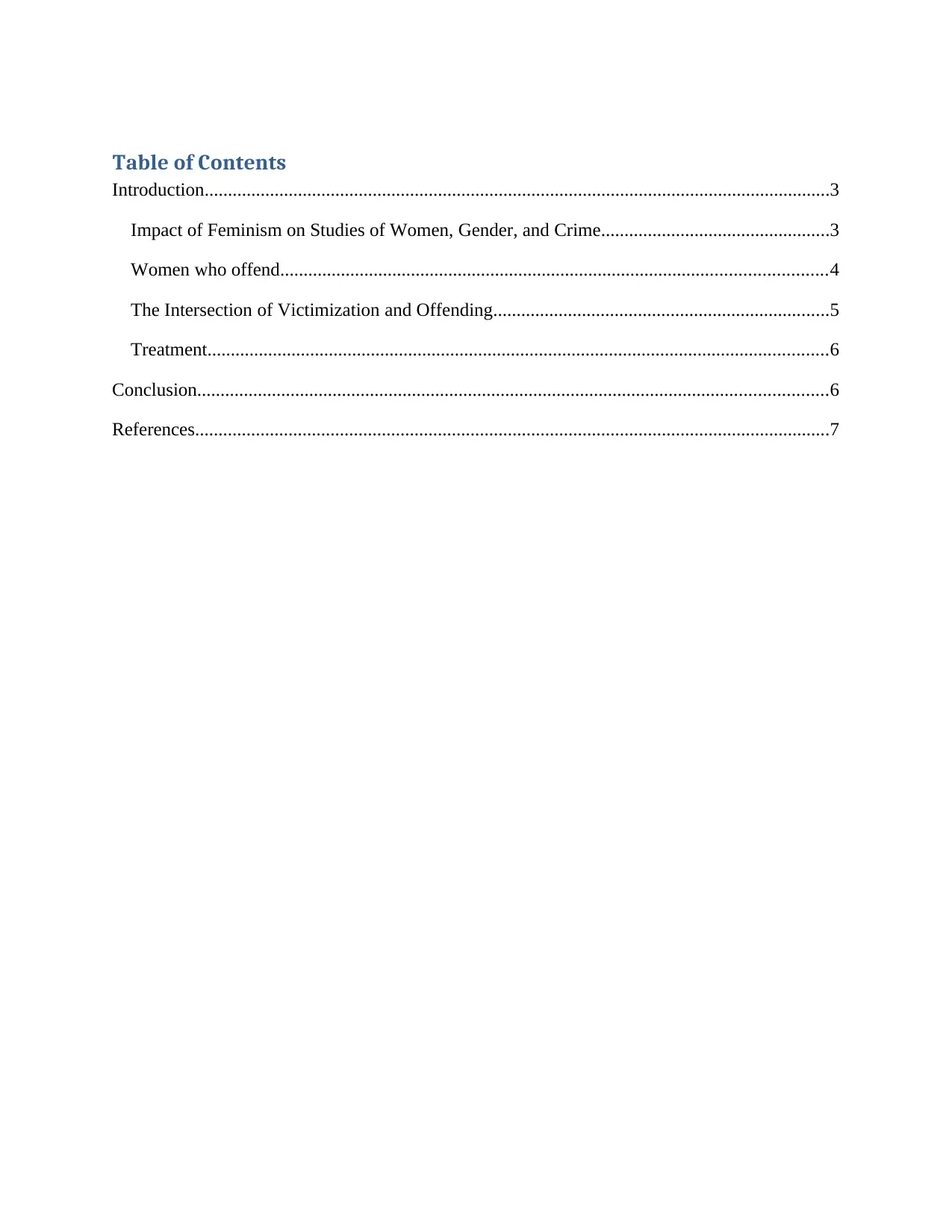
Table of Contents
Introduction......................................................................................................................................3
Impact of Feminism on Studies of Women, Gender, and Crime.................................................3
Women who offend.....................................................................................................................4
The Intersection of Victimization and Offending........................................................................5
Treatment.....................................................................................................................................6
Conclusion.......................................................................................................................................6
References........................................................................................................................................7
Introduction......................................................................................................................................3
Impact of Feminism on Studies of Women, Gender, and Crime.................................................3
Women who offend.....................................................................................................................4
The Intersection of Victimization and Offending........................................................................5
Treatment.....................................................................................................................................6
Conclusion.......................................................................................................................................6
References........................................................................................................................................7
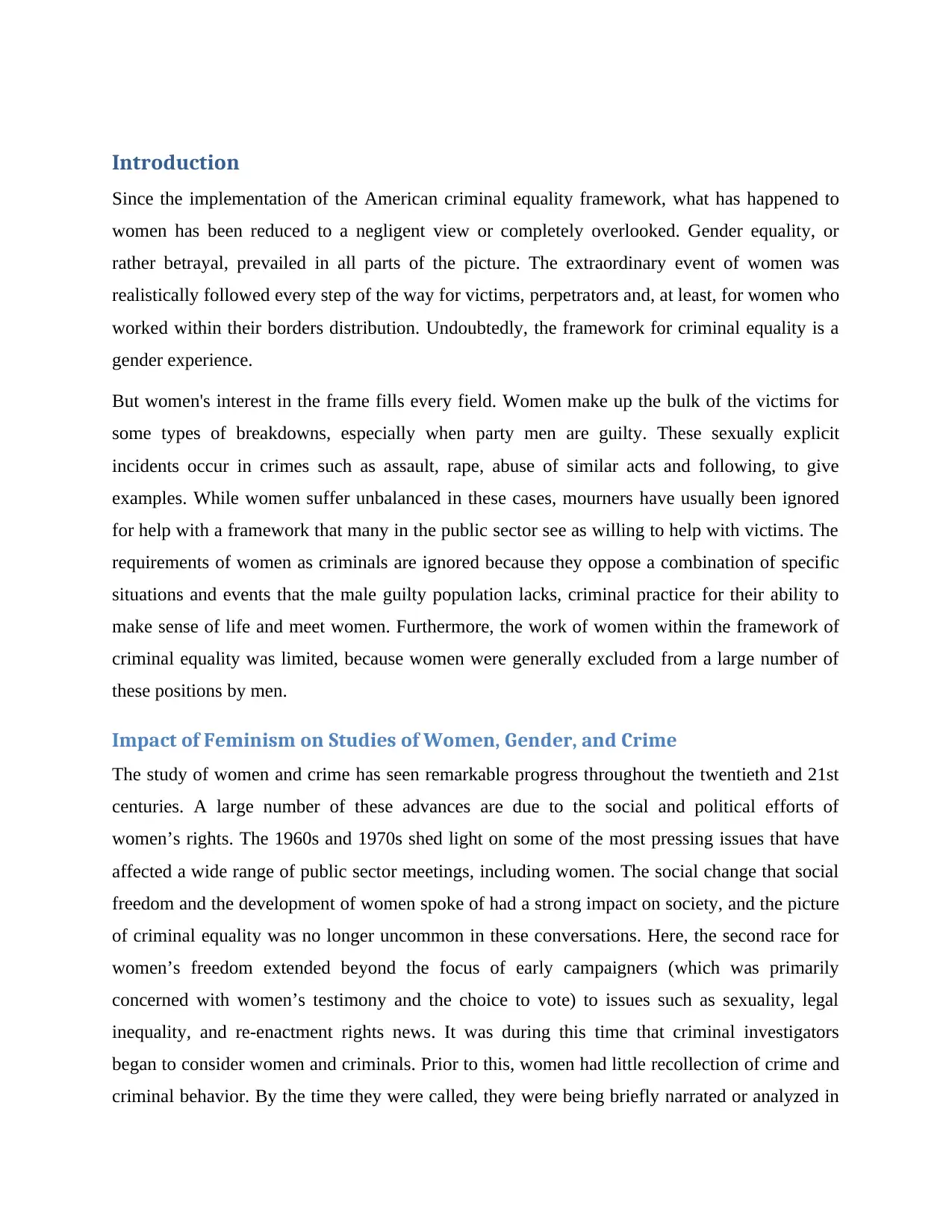
Introduction
Since the implementation of the American criminal equality framework, what has happened to
women has been reduced to a negligent view or completely overlooked. Gender equality, or
rather betrayal, prevailed in all parts of the picture. The extraordinary event of women was
realistically followed every step of the way for victims, perpetrators and, at least, for women who
worked within their borders distribution. Undoubtedly, the framework for criminal equality is a
gender experience.
But women's interest in the frame fills every field. Women make up the bulk of the victims for
some types of breakdowns, especially when party men are guilty. These sexually explicit
incidents occur in crimes such as assault, rape, abuse of similar acts and following, to give
examples. While women suffer unbalanced in these cases, mourners have usually been ignored
for help with a framework that many in the public sector see as willing to help with victims. The
requirements of women as criminals are ignored because they oppose a combination of specific
situations and events that the male guilty population lacks, criminal practice for their ability to
make sense of life and meet women. Furthermore, the work of women within the framework of
criminal equality was limited, because women were generally excluded from a large number of
these positions by men.
Impact of Feminism on Studies of Women, Gender, and Crime
The study of women and crime has seen remarkable progress throughout the twentieth and 21st
centuries. A large number of these advances are due to the social and political efforts of
women’s rights. The 1960s and 1970s shed light on some of the most pressing issues that have
affected a wide range of public sector meetings, including women. The social change that social
freedom and the development of women spoke of had a strong impact on society, and the picture
of criminal equality was no longer uncommon in these conversations. Here, the second race for
women’s freedom extended beyond the focus of early campaigners (which was primarily
concerned with women’s testimony and the choice to vote) to issues such as sexuality, legal
inequality, and re-enactment rights news. It was during this time that criminal investigators
began to consider women and criminals. Prior to this, women had little recollection of crime and
criminal behavior. By the time they were called, they were being briefly narrated or analyzed in
Since the implementation of the American criminal equality framework, what has happened to
women has been reduced to a negligent view or completely overlooked. Gender equality, or
rather betrayal, prevailed in all parts of the picture. The extraordinary event of women was
realistically followed every step of the way for victims, perpetrators and, at least, for women who
worked within their borders distribution. Undoubtedly, the framework for criminal equality is a
gender experience.
But women's interest in the frame fills every field. Women make up the bulk of the victims for
some types of breakdowns, especially when party men are guilty. These sexually explicit
incidents occur in crimes such as assault, rape, abuse of similar acts and following, to give
examples. While women suffer unbalanced in these cases, mourners have usually been ignored
for help with a framework that many in the public sector see as willing to help with victims. The
requirements of women as criminals are ignored because they oppose a combination of specific
situations and events that the male guilty population lacks, criminal practice for their ability to
make sense of life and meet women. Furthermore, the work of women within the framework of
criminal equality was limited, because women were generally excluded from a large number of
these positions by men.
Impact of Feminism on Studies of Women, Gender, and Crime
The study of women and crime has seen remarkable progress throughout the twentieth and 21st
centuries. A large number of these advances are due to the social and political efforts of
women’s rights. The 1960s and 1970s shed light on some of the most pressing issues that have
affected a wide range of public sector meetings, including women. The social change that social
freedom and the development of women spoke of had a strong impact on society, and the picture
of criminal equality was no longer uncommon in these conversations. Here, the second race for
women’s freedom extended beyond the focus of early campaigners (which was primarily
concerned with women’s testimony and the choice to vote) to issues such as sexuality, legal
inequality, and re-enactment rights news. It was during this time that criminal investigators
began to consider women and criminals. Prior to this, women had little recollection of crime and
criminal behavior. By the time they were called, they were being briefly narrated or analyzed in
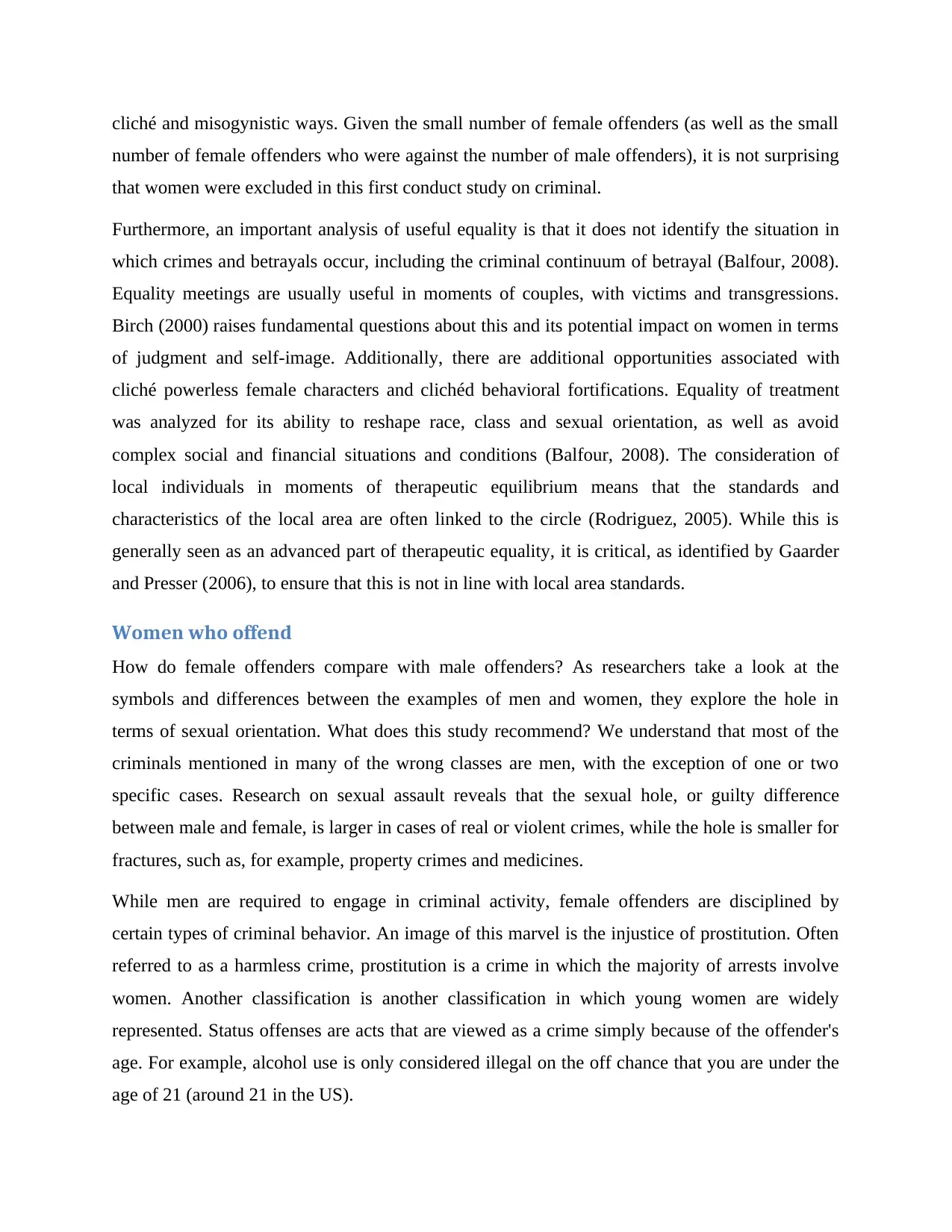
cliché and misogynistic ways. Given the small number of female offenders (as well as the small
number of female offenders who were against the number of male offenders), it is not surprising
that women were excluded in this first conduct study on criminal.
Furthermore, an important analysis of useful equality is that it does not identify the situation in
which crimes and betrayals occur, including the criminal continuum of betrayal (Balfour, 2008).
Equality meetings are usually useful in moments of couples, with victims and transgressions.
Birch (2000) raises fundamental questions about this and its potential impact on women in terms
of judgment and self-image. Additionally, there are additional opportunities associated with
cliché powerless female characters and clichéd behavioral fortifications. Equality of treatment
was analyzed for its ability to reshape race, class and sexual orientation, as well as avoid
complex social and financial situations and conditions (Balfour, 2008). The consideration of
local individuals in moments of therapeutic equilibrium means that the standards and
characteristics of the local area are often linked to the circle (Rodriguez, 2005). While this is
generally seen as an advanced part of therapeutic equality, it is critical, as identified by Gaarder
and Presser (2006), to ensure that this is not in line with local area standards.
Women who offend
How do female offenders compare with male offenders? As researchers take a look at the
symbols and differences between the examples of men and women, they explore the hole in
terms of sexual orientation. What does this study recommend? We understand that most of the
criminals mentioned in many of the wrong classes are men, with the exception of one or two
specific cases. Research on sexual assault reveals that the sexual hole, or guilty difference
between male and female, is larger in cases of real or violent crimes, while the hole is smaller for
fractures, such as, for example, property crimes and medicines.
While men are required to engage in criminal activity, female offenders are disciplined by
certain types of criminal behavior. An image of this marvel is the injustice of prostitution. Often
referred to as a harmless crime, prostitution is a crime in which the majority of arrests involve
women. Another classification is another classification in which young women are widely
represented. Status offenses are acts that are viewed as a crime simply because of the offender's
age. For example, alcohol use is only considered illegal on the off chance that you are under the
age of 21 (around 21 in the US).
number of female offenders who were against the number of male offenders), it is not surprising
that women were excluded in this first conduct study on criminal.
Furthermore, an important analysis of useful equality is that it does not identify the situation in
which crimes and betrayals occur, including the criminal continuum of betrayal (Balfour, 2008).
Equality meetings are usually useful in moments of couples, with victims and transgressions.
Birch (2000) raises fundamental questions about this and its potential impact on women in terms
of judgment and self-image. Additionally, there are additional opportunities associated with
cliché powerless female characters and clichéd behavioral fortifications. Equality of treatment
was analyzed for its ability to reshape race, class and sexual orientation, as well as avoid
complex social and financial situations and conditions (Balfour, 2008). The consideration of
local individuals in moments of therapeutic equilibrium means that the standards and
characteristics of the local area are often linked to the circle (Rodriguez, 2005). While this is
generally seen as an advanced part of therapeutic equality, it is critical, as identified by Gaarder
and Presser (2006), to ensure that this is not in line with local area standards.
Women who offend
How do female offenders compare with male offenders? As researchers take a look at the
symbols and differences between the examples of men and women, they explore the hole in
terms of sexual orientation. What does this study recommend? We understand that most of the
criminals mentioned in many of the wrong classes are men, with the exception of one or two
specific cases. Research on sexual assault reveals that the sexual hole, or guilty difference
between male and female, is larger in cases of real or violent crimes, while the hole is smaller for
fractures, such as, for example, property crimes and medicines.
While men are required to engage in criminal activity, female offenders are disciplined by
certain types of criminal behavior. An image of this marvel is the injustice of prostitution. Often
referred to as a harmless crime, prostitution is a crime in which the majority of arrests involve
women. Another classification is another classification in which young women are widely
represented. Status offenses are acts that are viewed as a crime simply because of the offender's
age. For example, alcohol use is only considered illegal on the off chance that you are under the
age of 21 (around 21 in the US).
Secure Best Marks with AI Grader
Need help grading? Try our AI Grader for instant feedback on your assignments.
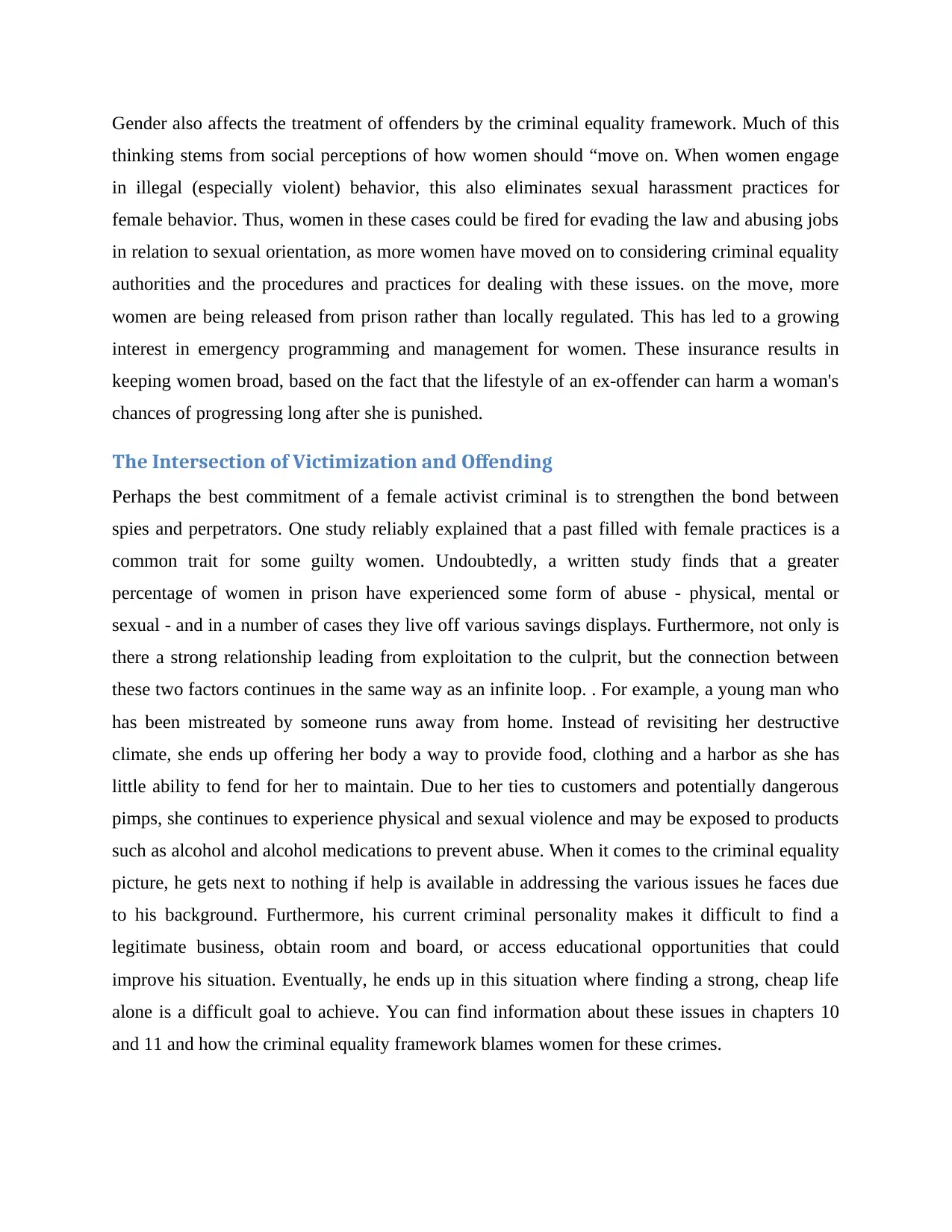
Gender also affects the treatment of offenders by the criminal equality framework. Much of this
thinking stems from social perceptions of how women should “move on. When women engage
in illegal (especially violent) behavior, this also eliminates sexual harassment practices for
female behavior. Thus, women in these cases could be fired for evading the law and abusing jobs
in relation to sexual orientation, as more women have moved on to considering criminal equality
authorities and the procedures and practices for dealing with these issues. on the move, more
women are being released from prison rather than locally regulated. This has led to a growing
interest in emergency programming and management for women. These insurance results in
keeping women broad, based on the fact that the lifestyle of an ex-offender can harm a woman's
chances of progressing long after she is punished.
The Intersection of Victimization and Offending
Perhaps the best commitment of a female activist criminal is to strengthen the bond between
spies and perpetrators. One study reliably explained that a past filled with female practices is a
common trait for some guilty women. Undoubtedly, a written study finds that a greater
percentage of women in prison have experienced some form of abuse - physical, mental or
sexual - and in a number of cases they live off various savings displays. Furthermore, not only is
there a strong relationship leading from exploitation to the culprit, but the connection between
these two factors continues in the same way as an infinite loop. . For example, a young man who
has been mistreated by someone runs away from home. Instead of revisiting her destructive
climate, she ends up offering her body a way to provide food, clothing and a harbor as she has
little ability to fend for her to maintain. Due to her ties to customers and potentially dangerous
pimps, she continues to experience physical and sexual violence and may be exposed to products
such as alcohol and alcohol medications to prevent abuse. When it comes to the criminal equality
picture, he gets next to nothing if help is available in addressing the various issues he faces due
to his background. Furthermore, his current criminal personality makes it difficult to find a
legitimate business, obtain room and board, or access educational opportunities that could
improve his situation. Eventually, he ends up in this situation where finding a strong, cheap life
alone is a difficult goal to achieve. You can find information about these issues in chapters 10
and 11 and how the criminal equality framework blames women for these crimes.
thinking stems from social perceptions of how women should “move on. When women engage
in illegal (especially violent) behavior, this also eliminates sexual harassment practices for
female behavior. Thus, women in these cases could be fired for evading the law and abusing jobs
in relation to sexual orientation, as more women have moved on to considering criminal equality
authorities and the procedures and practices for dealing with these issues. on the move, more
women are being released from prison rather than locally regulated. This has led to a growing
interest in emergency programming and management for women. These insurance results in
keeping women broad, based on the fact that the lifestyle of an ex-offender can harm a woman's
chances of progressing long after she is punished.
The Intersection of Victimization and Offending
Perhaps the best commitment of a female activist criminal is to strengthen the bond between
spies and perpetrators. One study reliably explained that a past filled with female practices is a
common trait for some guilty women. Undoubtedly, a written study finds that a greater
percentage of women in prison have experienced some form of abuse - physical, mental or
sexual - and in a number of cases they live off various savings displays. Furthermore, not only is
there a strong relationship leading from exploitation to the culprit, but the connection between
these two factors continues in the same way as an infinite loop. . For example, a young man who
has been mistreated by someone runs away from home. Instead of revisiting her destructive
climate, she ends up offering her body a way to provide food, clothing and a harbor as she has
little ability to fend for her to maintain. Due to her ties to customers and potentially dangerous
pimps, she continues to experience physical and sexual violence and may be exposed to products
such as alcohol and alcohol medications to prevent abuse. When it comes to the criminal equality
picture, he gets next to nothing if help is available in addressing the various issues he faces due
to his background. Furthermore, his current criminal personality makes it difficult to find a
legitimate business, obtain room and board, or access educational opportunities that could
improve his situation. Eventually, he ends up in this situation where finding a strong, cheap life
alone is a difficult goal to achieve. You can find information about these issues in chapters 10
and 11 and how the criminal equality framework blames women for these crimes.
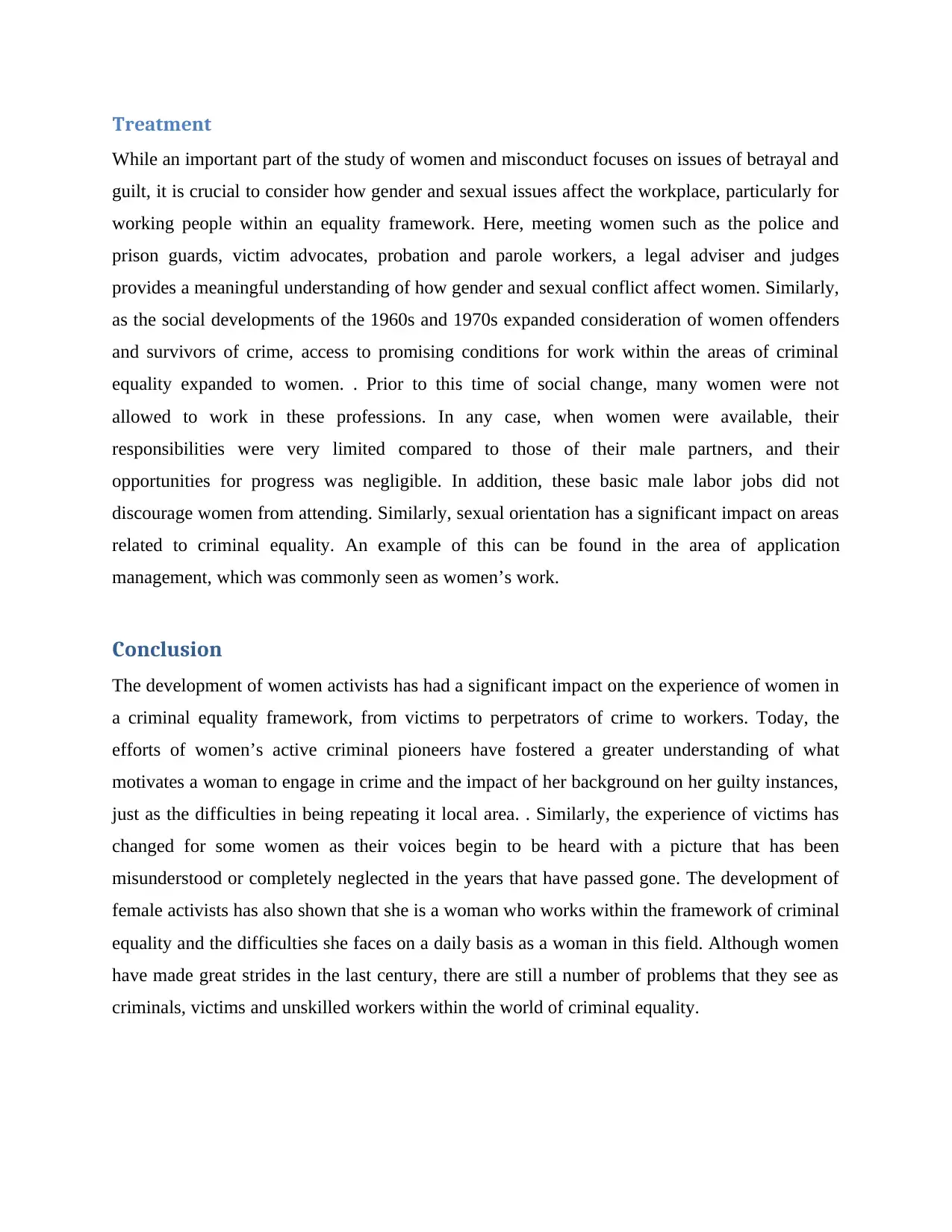
Treatment
While an important part of the study of women and misconduct focuses on issues of betrayal and
guilt, it is crucial to consider how gender and sexual issues affect the workplace, particularly for
working people within an equality framework. Here, meeting women such as the police and
prison guards, victim advocates, probation and parole workers, a legal adviser and judges
provides a meaningful understanding of how gender and sexual conflict affect women. Similarly,
as the social developments of the 1960s and 1970s expanded consideration of women offenders
and survivors of crime, access to promising conditions for work within the areas of criminal
equality expanded to women. . Prior to this time of social change, many women were not
allowed to work in these professions. In any case, when women were available, their
responsibilities were very limited compared to those of their male partners, and their
opportunities for progress was negligible. In addition, these basic male labor jobs did not
discourage women from attending. Similarly, sexual orientation has a significant impact on areas
related to criminal equality. An example of this can be found in the area of application
management, which was commonly seen as women’s work.
Conclusion
The development of women activists has had a significant impact on the experience of women in
a criminal equality framework, from victims to perpetrators of crime to workers. Today, the
efforts of women’s active criminal pioneers have fostered a greater understanding of what
motivates a woman to engage in crime and the impact of her background on her guilty instances,
just as the difficulties in being repeating it local area. . Similarly, the experience of victims has
changed for some women as their voices begin to be heard with a picture that has been
misunderstood or completely neglected in the years that have passed gone. The development of
female activists has also shown that she is a woman who works within the framework of criminal
equality and the difficulties she faces on a daily basis as a woman in this field. Although women
have made great strides in the last century, there are still a number of problems that they see as
criminals, victims and unskilled workers within the world of criminal equality.
While an important part of the study of women and misconduct focuses on issues of betrayal and
guilt, it is crucial to consider how gender and sexual issues affect the workplace, particularly for
working people within an equality framework. Here, meeting women such as the police and
prison guards, victim advocates, probation and parole workers, a legal adviser and judges
provides a meaningful understanding of how gender and sexual conflict affect women. Similarly,
as the social developments of the 1960s and 1970s expanded consideration of women offenders
and survivors of crime, access to promising conditions for work within the areas of criminal
equality expanded to women. . Prior to this time of social change, many women were not
allowed to work in these professions. In any case, when women were available, their
responsibilities were very limited compared to those of their male partners, and their
opportunities for progress was negligible. In addition, these basic male labor jobs did not
discourage women from attending. Similarly, sexual orientation has a significant impact on areas
related to criminal equality. An example of this can be found in the area of application
management, which was commonly seen as women’s work.
Conclusion
The development of women activists has had a significant impact on the experience of women in
a criminal equality framework, from victims to perpetrators of crime to workers. Today, the
efforts of women’s active criminal pioneers have fostered a greater understanding of what
motivates a woman to engage in crime and the impact of her background on her guilty instances,
just as the difficulties in being repeating it local area. . Similarly, the experience of victims has
changed for some women as their voices begin to be heard with a picture that has been
misunderstood or completely neglected in the years that have passed gone. The development of
female activists has also shown that she is a woman who works within the framework of criminal
equality and the difficulties she faces on a daily basis as a woman in this field. Although women
have made great strides in the last century, there are still a number of problems that they see as
criminals, victims and unskilled workers within the world of criminal equality.
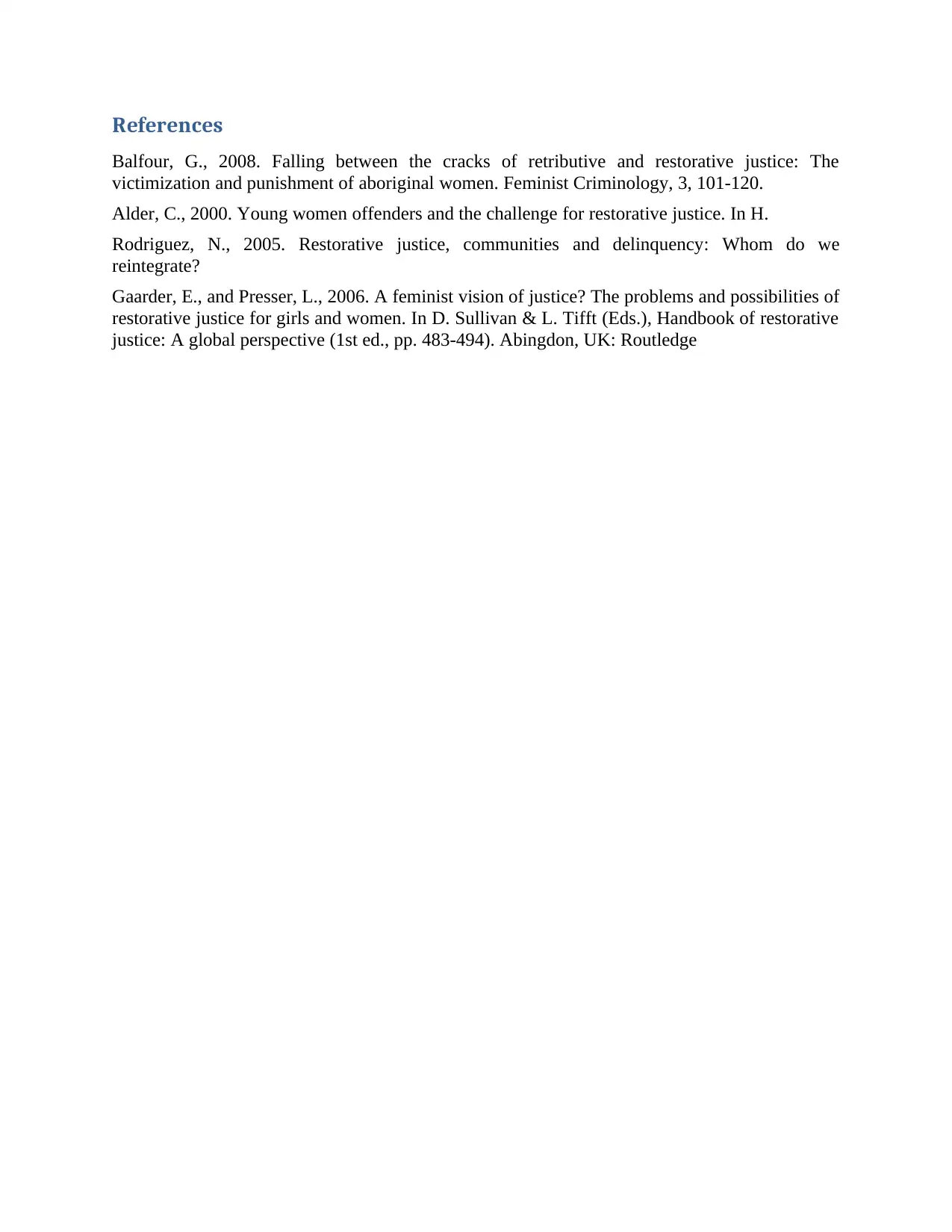
References
Balfour, G., 2008. Falling between the cracks of retributive and restorative justice: The
victimization and punishment of aboriginal women. Feminist Criminology, 3, 101-120.
Alder, C., 2000. Young women offenders and the challenge for restorative justice. In H.
Rodriguez, N., 2005. Restorative justice, communities and delinquency: Whom do we
reintegrate?
Gaarder, E., and Presser, L., 2006. A feminist vision of justice? The problems and possibilities of
restorative justice for girls and women. In D. Sullivan & L. Tifft (Eds.), Handbook of restorative
justice: A global perspective (1st ed., pp. 483-494). Abingdon, UK: Routledge
Balfour, G., 2008. Falling between the cracks of retributive and restorative justice: The
victimization and punishment of aboriginal women. Feminist Criminology, 3, 101-120.
Alder, C., 2000. Young women offenders and the challenge for restorative justice. In H.
Rodriguez, N., 2005. Restorative justice, communities and delinquency: Whom do we
reintegrate?
Gaarder, E., and Presser, L., 2006. A feminist vision of justice? The problems and possibilities of
restorative justice for girls and women. In D. Sullivan & L. Tifft (Eds.), Handbook of restorative
justice: A global perspective (1st ed., pp. 483-494). Abingdon, UK: Routledge
1 out of 7
Related Documents
Your All-in-One AI-Powered Toolkit for Academic Success.
+13062052269
info@desklib.com
Available 24*7 on WhatsApp / Email
![[object Object]](/_next/static/media/star-bottom.7253800d.svg)
Unlock your academic potential
© 2024 | Zucol Services PVT LTD | All rights reserved.





